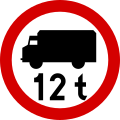Key:maxweightrating
| Description |
|---|
| Legal access restriction for vehicles with a max allowed weight above the specified weight in metric tonnes. |
| Group: restrictions |
| Used on these elements |
| Useful combination |
|
| See also |
|
| Status: in use |
| Tools for this tag |
|
Legal access restriction for vehicles with a ![]() max allowed weight above the specified weight in metric tonnes.
max allowed weight above the specified weight in metric tonnes.
The maximum allowed weight, also known as the gross vehicle weight rating (GVWR), gross vehicle mass (GVM), Permissible maximum mass or max gross weight (MGW) is the maximum permitted weight of the vehicle at full load, as specified by the manufacturer. For example, in most countries, heavy goods vehicles on Wikipedia are defined as goods vehicles with a GVWR above 3.5 tonnes.
Note that such restrictions often, though not always, apply only to certain classes of vehicles (e.g. HGVs) and may have exceptions. See below for example signs where the relevant highway should be tagged maxweightrating:hgv=* or maxweightrating:goods=*, as well as maxweightrating:conditional=*.
Difference to maxweight=*
The definition may be confusing, but it is really rather simple. Here is an example:
Sign Tag Meaning 
maxweight=5.5 Vehicles that currently weight above 5.5 t are prohibited on this road. 
maxweightrating:hgv=5.5 Lorries that are legally permitted to weigh (i.e., at full load) more than 5.5 t are prohibited on this road.
So the latter sign is a more precise way for the road traffic authority to say that access for "big lorries" is prohibited and has nothing to do with the vehicle's current actual weight. A similar mechanism is the "Unladen mass" (Chap. 1, Art. 1 (x) Vienna Convention on Road Traffic); e.g., in the United States the "empty weight" restriction, for which maxunladenweight=* has been proposed.
For example, an empty truck that weighs 5 t and can carry 10 t has
- current weight of 5 t
- max permitted weight of 15 t
It means that it may pass through a road signed with maxweight=10 but not through one signed with maxweightrating=10
Example signs
with signs around the world:
maxweightrating sign
Queensland in Australia:
maxweightrating=*United Kingdom:
maxweightrating=7.5
maxweightrating:hgv sign
Austria:
maxweightrating:hgv=5.5 (use dot as a separator in the tag)Germany:
maxweightrating:hgv=7.5
traffic_sign=DE:253,1052-35Ireland:
hgv=no maxweightrating:goods=3.5Israel:
maxweightrating:hgv=4Italy:
maxweightrating:hgv=7.5 (use dot as a separator in the tag)Poland:
maxweightrating:hgv=12Southern African Development Community:
maxweightrating:hgv=10Sweden:
maxweightrating:hgv=30United Kingdom:
maxweightrating:hgv=7.5
maxweightrating:bus sign
Austria:
maxweightrating:bus=7.5 (use dot as a separator in the tag)
Related tags
Legal references
Vienna Convention on Road Traffic (Nov 8, 1968)
This property relates to Chapter 1, Art. 1 (w) "Permissible maximum mass means the maximum mass of the laden vehicle declared permissible by the competent authority of the State in which the vehicle is registered;"
See also
References
- ↑ Unless specified otherwise value defaults to 3.5 tons, technically maxweightrating:hgv=3.5 may be used but meaning of hgv=no is the same and that tagging is simpler - in Poland, like most countries trucks are defined as goods vehicles with maximum allowed weight above 3.5 tonnes.
- ↑ Sign that prohibits vehicles intended for/or carrying goods. Additionally, a sign may be present prohibiting vehicles whose laden mass is higher than the mass indicated on the sign. In that case, use: goods:conditional=no @ (weight>*) and hgv:conditional=no @ (weight>*)













![Poland: hgv=no[1]](https://upload.wikimedia.org/wikipedia/commons/thumb/0/0d/PL_road_sign_B-5.svg/120px-PL_road_sign_B-5.svg.png)
![Belgium: goods=no and hgv=no[2]](https://upload.wikimedia.org/wikipedia/commons/thumb/a/ad/Belgian_traffic_sign_C23.svg/120px-Belgian_traffic_sign_C23.svg.png)